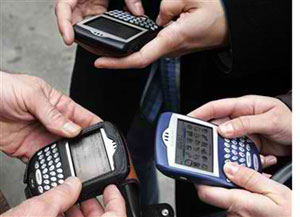O’ Christmas tree, to mulch with thee!
January 6, 2011
 No matter where you hang your stockings in Los Angeles County, there’s a recycling program in place to give your increasingly brown Christmas tree a green send-off.
No matter where you hang your stockings in Los Angeles County, there’s a recycling program in place to give your increasingly brown Christmas tree a green send-off.
The Department of Public Works is picking up trees through January 15 in unincorporated areas of L.A. County. Simply place your tree curbside on your regular trash collection day. The City of L.A. will be collecting trees placed in or beside green waste bins. For more details, please visit the City Bureau of Sanitation.
You can also drop off trees at numerous collection sites throughout the county. For locations and a list of city-specific tree recycling guidelines, go to http://www.cleanla.com or call 1(888)-CLEANLA.
Before taking advantage of any of these recycling programs, which transform the trees into compost, mulch or ground cover, make sure all ornaments, tree strands and tinsel have been removed.
By recycling your tree, you’ll not only be helping the planet, you’ll also be protecting yourself and your property from fire risks that come with old trees. According to the United States Fire Administration, dried out holiday trees account for 250 fires annually, causing deaths, injuries, and millions of dollars in property damage.
If that doesn’t grab your attention, here’s video of a spruce setting an entire room ablaze in 40 seconds:
Keep that resolution now – ask us how!
January 6, 2011

Quit smoking! Stop drinking! Earn more! Owe less! Get that degree while shedding 10 pounds of belly fat!
If these are among your New Year’s resolutions, we’d suggest one more: buyer beware. For as surely as the ball drops in Times Square, scammers are gearing up to take advantage of your good intentions.
So how can you maintain your resolve in 2011 while steering clear of pitfalls? We asked Rigo Reyes, acting director of the county’s Department of Consumer Affairs, whose experts looked at some popular resolutions and offered these tips.
 Get healthy. “We see a lot of weight-loss programs,” says Reyes, whose team recently has been forwarding complaints and inquiries to the California Medical Board about lap band surgery. But that’s just one get-healthy-quick pitch among many. Faith healers in bogus farmacias prey on Spanish-speaking consumers who want to quit drinking or smoking or overeating. And every year, Reyes says, he hears from couch potatoes who bought sales pitches from some gyms without actually reading the high-priced contracts. “People need to read the fine print and not just believe promises,” says Reyes. Short cuts are imaginary and costly. A walk around the block, on the other hand, is free.
Get healthy. “We see a lot of weight-loss programs,” says Reyes, whose team recently has been forwarding complaints and inquiries to the California Medical Board about lap band surgery. But that’s just one get-healthy-quick pitch among many. Faith healers in bogus farmacias prey on Spanish-speaking consumers who want to quit drinking or smoking or overeating. And every year, Reyes says, he hears from couch potatoes who bought sales pitches from some gyms without actually reading the high-priced contracts. “People need to read the fine print and not just believe promises,” says Reyes. Short cuts are imaginary and costly. A walk around the block, on the other hand, is free.
 Get out of debt. “This is a top priority for a lot of people in this economy,” says Reyes. But beware of credit repair scams and offers of foreclosure assistance and debt consolidation. No one can legally remove accurate information from a credit report, and if the information is inaccurate, you can get it removed for nothing. If you’re having foreclosure troubles, deal directly with the bank or get help from a HUD-approved nonprofit—don’t waste money on for-profit intermediaries. As for debt consolidation offers, Reyes says many leave consumers with high fees, unpaid debts and worse credit. Scams such as these have become so predatory that new laws have been passed to address them. Up-front fees are now illegal for credit repair, loan modification and foreclosure assistance in California. A new federal telemarketing rule also prohibits them for debt consolidation services offered through phone sales. If you really need help, Reyes says, contact the Consumer Affairs Department at (800) 593-8222 or (213) 974-1452: “We’ll help you out for free.”
Get out of debt. “This is a top priority for a lot of people in this economy,” says Reyes. But beware of credit repair scams and offers of foreclosure assistance and debt consolidation. No one can legally remove accurate information from a credit report, and if the information is inaccurate, you can get it removed for nothing. If you’re having foreclosure troubles, deal directly with the bank or get help from a HUD-approved nonprofit—don’t waste money on for-profit intermediaries. As for debt consolidation offers, Reyes says many leave consumers with high fees, unpaid debts and worse credit. Scams such as these have become so predatory that new laws have been passed to address them. Up-front fees are now illegal for credit repair, loan modification and foreclosure assistance in California. A new federal telemarketing rule also prohibits them for debt consolidation services offered through phone sales. If you really need help, Reyes says, contact the Consumer Affairs Department at (800) 593-8222 or (213) 974-1452: “We’ll help you out for free.”
 Get a job. If the jobless rate is any indication, millions of Californians share this resolution. But employment scams are already worsening life for the desperate. “A lot of them are phishing schemes and bogus mystery shopper programs—you get an email from people claiming to be ‘recruiters’ who can get you a job if you just give them your information, which then leaves you vulnerable to identity theft.” Some of these job scammers go further. They send bogus checks to people to purportedly finance their “start-up” costs. The victims are told to deposit the checks and wire back a portion to third parties. Because the law requires banks to make the funds from the deposited check available before the check completely clears, the scammers get away with the money, which the bank will try to collect from you.
Get a job. If the jobless rate is any indication, millions of Californians share this resolution. But employment scams are already worsening life for the desperate. “A lot of them are phishing schemes and bogus mystery shopper programs—you get an email from people claiming to be ‘recruiters’ who can get you a job if you just give them your information, which then leaves you vulnerable to identity theft.” Some of these job scammers go further. They send bogus checks to people to purportedly finance their “start-up” costs. The victims are told to deposit the checks and wire back a portion to third parties. Because the law requires banks to make the funds from the deposited check available before the check completely clears, the scammers get away with the money, which the bank will try to collect from you.
 Get a degree. Great resolution, but only if you can use the diploma, so look out for unaccredited and for-profit schools. “The private post-secondary bureau in the state Department of Consumer Affairs used to license these schools, but the legislation authorizing it was allowed to sunset three years ago,” says Reyes. “People are trying to re-establish it, but in the meantime, there has been a free-for-all.” If you want to take classes or get job training, he says, apply to an accredited university, enroll at a community college or check out adult education programs at your local high school. “The Evans Adult School, which is part of the Los Angeles Unified School District, has a very comprehensive program,” says Reyes, “and you don’t have to pay anything but $5 for a student I.D.”
Get a degree. Great resolution, but only if you can use the diploma, so look out for unaccredited and for-profit schools. “The private post-secondary bureau in the state Department of Consumer Affairs used to license these schools, but the legislation authorizing it was allowed to sunset three years ago,” says Reyes. “People are trying to re-establish it, but in the meantime, there has been a free-for-all.” If you want to take classes or get job training, he says, apply to an accredited university, enroll at a community college or check out adult education programs at your local high school. “The Evans Adult School, which is part of the Los Angeles Unified School District, has a very comprehensive program,” says Reyes, “and you don’t have to pay anything but $5 for a student I.D.”
Posted 12/05/11
They count. Will you?
January 5, 2011

At last count, some 42,694 homeless men, women and children were struggling on the streets of Los Angeles County.
That last count was two years ago. The next count begins later this month, when cities and counties across the nation—Los Angeles among them—will take to the recession-wracked sidewalks, shelters, hospitals, jails and underpasses in a crucial, federally mandated effort to attach hard numbers to the vexing issue of homelessness.
To that end, the Los Angeles Homeless Services Authority, which conducts the biennial head count for the city and county, is looking for a few thousand sharp-eyed volunteers. Enumerators will be asked to donate five hours during the week nights of January 25-27, or during the morning of January 27, to fan out across the county in search of homeless people and help document their existence. Training and security will be provided; volunteers won’t interact with the homeless, just observe and tally.
“We need 4,000 people,” says LAHSA Communications Director Calvin J. Fortenberry, noting that the opportunity is open to any volunteer over 18.
“These counts are aimed at assessing the severity of the problem here and then moving people into housing. It’s a unique volunteer experience, one that goes beyond the usual clothing or food drive.”
The U.S. Department of Housing and Urban Development has required the count since 2005 as a condition for federal funding for homeless programs, despite the inherent difficulties in tracking people who, by definition, have no fixed address.
The challenge is particularly tough in Los Angeles County—a metropolis the size of Rhode Island and Delaware put together—but the data have offered one of the few sources of hard information on the issue, and the count has helped local authorities determine how best to allocate services for the homeless.
The 2009 count revealed, for instance, that two-thirds of the area’s homeless had no shelter, that about a quarter were mentally ill, that a third were women and that about one in six were veterans. It also confirmed that homelessness extends well beyond Skid Row to every corner of the county.
At the same time, however, it indicated that although the homeless population in Greater L.A. remains the nation’s largest, the problem appears to be shrinking. Volunteers counted 88,345 homeless people in 2005, but found only 68,808 in 2007 and just 42,694 in 2009—a drop of nearly 52% in four years even though the area was reeling from financial collapse and record foreclosures. Some of that drop, however, can be attributed to a shift in the count methodologies. In the first counts, the results relied mostly on extrapolations. More recently, there have been growing efforts to increase the accuracy of those numbers by conducting full counts–an effort requiring even more volunteers.
Some advocates for the homeless took issue, concerned both that the statistics were not reflecting the demand they were experiencing on the front lines, and that falling numbers might translate into diminished funding.
Fortenberry says all this just underscores the importance of the count in 2011.
“This is all the more reason to get involved,” he says. “We’re focusing on the need, and the need is more than 40,000 people with no permanent place to live.”
Interested in helping? Click here, or contact LAHSA at (213) 225-8433 or go to theycountwillyou.org.
Checking for county cell phone static
January 4, 2011

With more than 17,000 cell phones, Blackberries and other mobile communications devices out there in the hands of Los Angeles County employees, supervisors sent a loud and clear signal to department heads Tuesday:
Look who’s talking—and make sure that the public isn’t being stuck with any unwarranted roaming, texting, directory assistance and other service charges.
On the heels of an audit that found widespread cell phone abuse and lax oversight in the Department of Children and Family Services, supervisors voted to initiate a countywide policy to make sure proper controls are in place across the county’s entire mobile communications network. There currently is no centralized oversight of the county’s cell phones; instead, that responsibility falls to individual departments.
It’s a big responsibility—and it’s growing. An inventory of handheld communication devices by the county’s Chief Information Office forecasts that the number of cell phones and similar devices being used by county workers will grow from 17,657 this fiscal year to 19,304 in the next one.
Supervisors, acting on a motion by Michael D. Antonovich and Gloria Molina, on Tuesday directed all county department heads to conduct internal reviews of their cell phone control practices and report back on whether they found any issues similar to those that turned up in the DCFS audit.
That probe found at least $514,000 in potentially inappropriate charges as well as 250 cell phones whose users could not be identified and 1,400 cell phones that were running up monthly service fees even though they weren’t being used. One employee racked up more than $2,000 in personal international calls but did not reimburse the department, while another’s phone was linked to $8,000 in service charges, including roaming charges from Mexico. Still another employee ran up $2,827 in texting charges over the course of a year.
DCFS reported a combined total of 3,699 cell phones and Blackberry/PDA devices in the Chief Information Office’s inventory—nearly 21% of the county total. The department spends about $2.2 million a year on its cell phones. The county’s overall spending on mobile devices could not immediately be determined. A Chief Executive Office analysis to determine whether the county would save money by giving employees a stipend for cell phones, instead of paying the bills directly, was launched before the DCFS audit came out but has not been completed.
The motion passed by supervisors on Tuesday also directed the county Auditor-Controller, which conducted the DCFS audit, to cast its net more broadly in the next 12 months to ensure that various county departments have enacted cell phone policies and controls and are complying with them. And it asked for a progress report in 30 days on how the DCFS is progressing on implementing reform recommendations spelled out in the Auditor-Controller’s audit.
Posted 1/4/11









 Check for the latest closure information
Check for the latest closure information








